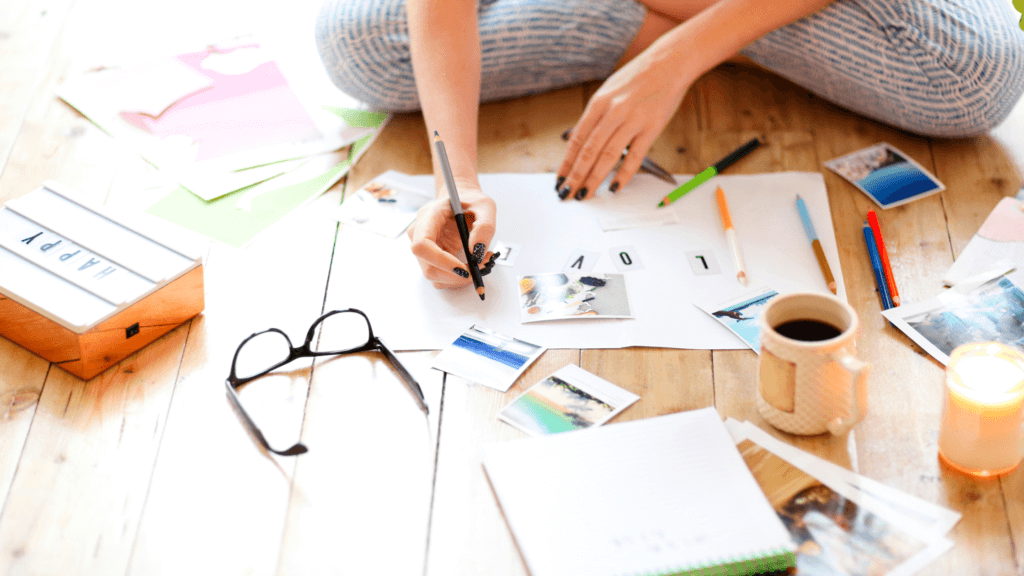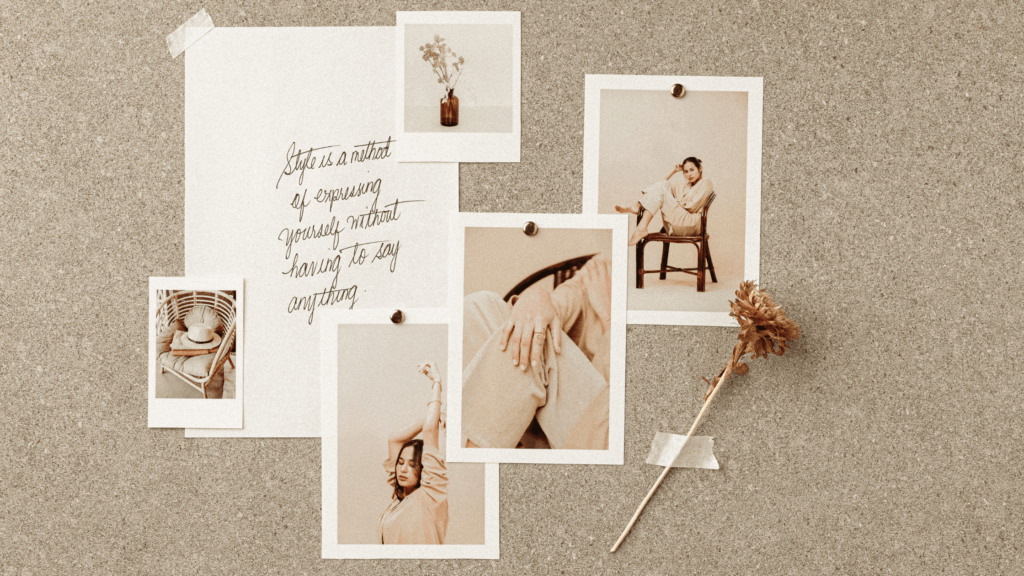Have you ever felt overwhelmed by your thoughts and emotions, struggling to put them into words or actions? Sometimes, the best way to navigate these feelings is not through words, but through visual representation. This is where a mood board comes in. Originally used as a creative tool by designers and artists, mood boards are now becoming a powerful tool for personal development and mental health as well. Creating a mood board allows you to visually express your aspirations, ideas, and emotions, helping to clarify your thoughts and stay focused on what inspires you.
In this article, we’ll explore what mood boards are, how they can benefit your mental well-being, and how you can create and use one in your everyday life for personal growth and emotional regulation.

What Is a Mood Board?
A mood board is a collage of images, colors, text, and other visual elements that reflect a particular theme, mood, or concept. It’s often used by visual professionals to communicate a particular feeling or aesthetic, but its applications go far beyond just design. By bringing together different elements, mood boards create a visual representation of thoughts or goals, which can be incredibly grounding and motivating.
Think of a mood board as a vision board but with a broader scope. Instead of just goals, a mood board can capture how you want to feel, the atmosphere you want to create in your life, or even the inner journey you wish to embark on. It can be a powerful way to focus your intentions and bring clarity to your mental and emotional state.
How Can a Mood Board Benefit Your Mental Health?
1. Clarifies Your Emotions
Sometimes, putting emotions into words can be challenging. Mood boards offer an alternative way to understand and express your feelings through imagery. By choosing pictures and colors that resonate with you, you can externalize what’s going on inside, creating a tangible representation of your emotional state.
2. Promotes Mindfulness
The process of making a mood board encourages you to slow down, reflect, and choose elements that resonate with you. It can be a relaxing, meditative activity that promotes mindfulness. When creating your mood board, you become more present in the moment—focusing on what visually represents your thoughts and feelings.
3. Enhances Motivation
A mood board can act as a visual reminder of what inspires and motivates you. Whether it’s the atmosphere you want to create in your home, personal goals you’re aiming for, or qualities you want to cultivate within yourself, a mood board helps you maintain focus and stay aligned with your values and aspirations.
4. Encourages Creative Expression
Using colors, images, and words to express how you feel can be incredibly freeing. Mood boards can help you tap into your creative side and allow for expression beyond language. This can be particularly helpful if you’re feeling emotionally blocked or need a creative outlet.
How to Create a Mood Board in Real Life
1. Decide on Your Theme
Before you start collecting images and materials, it’s helpful to decide on a theme for your mood board. Ask yourself: what do you want this mood board to represent? It could be a future goal, a feeling, a phase in your life, or something you want to bring into your life—such as peace, creativity, or joy.
2. Collect Your Materials
You can create a physical or digital mood board, depending on your preference. For a physical mood board, gather magazines, printed images, scissors, glue, and a board or large piece of paper. For a digital mood board, you can use online tools such as Pinterest, Canva, or even a Word document.
3. Choose Images, Colors, and Words
Start collecting elements that represent your theme. You can cut out images from magazines, print photos, or find textures and patterns that resonate with you. Colors are especially powerful—different colors can evoke different emotions, so choose ones that reflect the mood you want to convey.
If you’re focusing on a specific goal, include inspirational quotes or affirmations. If you want to create a calming mood board, look for serene landscapes, soft colors, and soothing imagery. Let your intuition guide you, and pick whatever speaks to you without overthinking it.
4. Assemble Your Board
Lay out your images and materials, experimenting with different arrangements until something feels right. There’s no “wrong” way to do this—allow yourself the freedom to arrange your board in a way that feels meaningful to you. Once you’re happy with the layout, glue the images in place if it’s a physical board, or save your collage if it’s digital.
5. Reflect on Your Mood Board
Once you’ve completed your mood board, take some time to sit with it. Reflect on how it makes you feel. Does it resonate with your original theme? How do the colors and images speak to you? Display your mood board somewhere you’ll see it often, as a visual reminder of what you’re striving for or what inspires you.
Real-Life Applications of Mood Boards

Mood Boards and Perception Styles
Different people process information in different ways—some are more visual, while others respond better to words, sounds, or even tactile experiences. Mood boards are particularly effective for individuals with a strong visual perception style, as they allow thoughts, feelings, and aspirations to be expressed through imagery. However, mood boards are beneficial for everyone, regardless of their primary perception style, because we are all influenced by what we see on a deep level. By intentionally curating positive and inspiring visuals, we can literally influence our mood and create better, more empowering thoughts. This visual reinforcement can help us shape our attitudes and work toward the future we envision for ourselves through the mood board.
Using Technology to Create a Mood Board
In today’s digital world, technology makes creating mood boards easier and more accessible. Platforms like Pinterest allow you to collect images and arrange them into a virtual mood board that you can access anytime. You can also use AI tools to generate custom images that reflect your mood or theme. These images can then be printed out or set as screensavers to lift your spirits and keep you aligned with your aspirations. Creating a mood board digitally is not only convenient, but it also allows you to modify and update your board effortlessly as your mood or goals evolve.
Daily Inspiration
Mood boards can serve as a daily source of inspiration and motivation. Seeing a visual representation of your goals or aspirations every day can help you stay on track and remain focused. It serves as a reminder of what matters to you, encouraging positive action and progress.
Emotional Regulation
When you’re feeling overwhelmed, stressed, or anxious, taking a few minutes to create or update your mood board can help you refocus and calm down. The act of engaging with colors, images, and textures is grounding and can help bring you back to a more balanced emotional state.
Vision Setting
Similar to vision boards, mood boards can help you clarify your goals and set intentions for the future. Whether it’s improving your mental health, advancing your career, or creating a positive home environment, a mood board can help make your intentions more tangible.
Communicating Ideas
Mood boards are also helpful for communicating ideas to others. If you’re working on a collaborative project, creating a mood board can help communicate the vibe or atmosphere you’re aiming for more effectively than words alone.
Conclusion
Mood boards are a powerful tool for visualizing your thoughts, emotions, and goals. Whether you’re looking to clarify your feelings, create a sense of calm, or focus on a future aspiration, a mood board can help you get there. It’s a creative and reflective practice that can enhance mindfulness, boost motivation, and promote emotional well-being. So why not give it a try? Gather your favorite images, put them together, and watch as your thoughts and feelings take on a more vivid, tangible form.
Take some time today to create your own mood board. Whether it’s physical or digital, let your intuition guide you as you gather images and words that resonate with you. Let this mood board be a reflection of your inner world, and a source of inspiration and calm in your everyday life.

